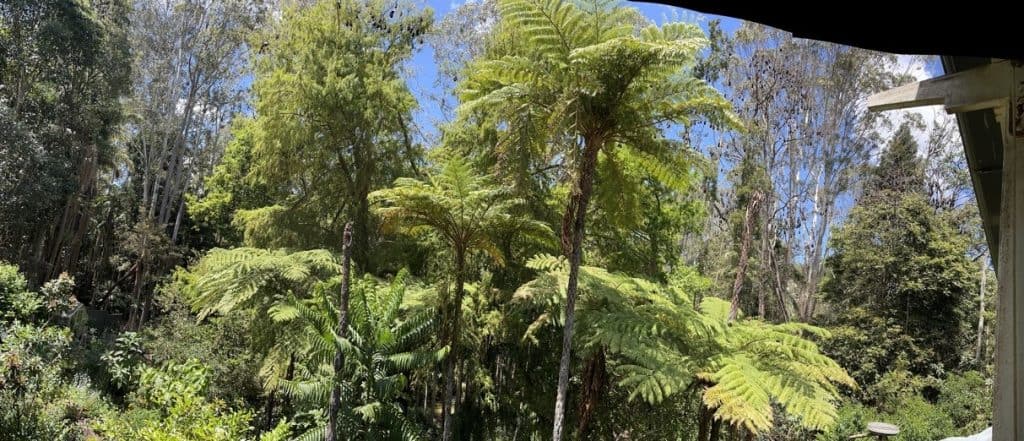By Suzie Haddock
We live on an acre with the house and garden right at the front.
Two thirds of our land is a wildlife corridor with a creek running through it.
We have at least 35 species of birds (including 5 birds of prey and 4 other predatory birds), 3 species of snakes, pink-tongued skinks, Three-toed Snake-tooth skink, 5 frog species, as well as koalas who use the corridor but don’t stay.
We have very large Quandongs, White Beech, Red Cedar, many Eucalypts, palms as well as the introduced Mexican Cypress.
When we went to buy a house in the area over 2.5 years ago, we were very open to what was available. We had looked at a few properties but when we saw this one, flying foxes and all, we fell in love. The creek at different times of day is beautiful in the rainforest light and we knew that the constant flow of water would attract many animals.
Flying foxes prefer to roost near a permanent water source.
We have two species of flying fox at our place. The Grey-headed Flying Fox that you see here.
And the Black Flying Fox. They live here for approximately 6 months of each year.
Spring at our place
In October, the Flying Foxes come back to their roost. Sometimes the only way you know that they are back is when you hear a twittering sound, as they chatter to each other.
Generally, during the day they are pretty quiet – in fact as I write this I can’t hear anything except our washing machine and a few birds, probably the noisy lorikeets, calling out the back.
It’s a roost. It’s a breeding colony
Flying foxes have a gestation of about six months. When they come back to their roost (at our place) in Spring they give birth or are carrying very small young. In fact, one gave birth last Tuesday.
The young go straight onto the mother’s teat to suckle. And the babies will stay safely tucked under their wing, going on foraging journeys at night, until they are furred and too big for the mothers to take them with them – at about 3-4 weeks.
Although flying foxes can have twins both rarely survive.
Summer
By the time summer comes along many of the babies are being left behind in creche’s while their mother’s go off to feed. The flying foxes are particularly quiet when it is hot, as they try to conserve their energy. It takes a lot of energy to fly.
Disturbances from birds of prey or from neighbours can cause the colony to panic, which of course can cause overheating if it’s a hot day and a serious loss of energy.
It’s interesting that while loud noises can disturb the colony, they are so used to us that they aren’t disturbed if we start the mower or the blower on the roof, or play loud music.
Autumn
In Autumn, the colony becomes noisier. The males want to mate with the females. More babies are being left behind and when they welcome their mother’s back they call out.
Although in the early morning it can be rowdy, I hope that all the mothers return and I console myself that it is the mothers and babies finding each other and vocalizing that is causing the noise. Flying foxes have 20-40 vocalisations and similar hearing to us.
The smell
People tell me they can’t stand the musky smell of the males when they want to mate with the females. Honestly, we don’t usually notice it and when we do we’re not repelled by it. I guess that some people are more sensitive to it than us.
In March/April when it starts to get cold in Witta the flying foxes leave. Sometimes the majority of adults go first with just the maternity mothers coming back in the morning, who eventually take their young (sometimes 3-4 days later) and they are gone until spring.
For us
“They’re only noisy when they argue, just like humans… a little domestic here or there.”
We are more disturbed by bat-free neighbours who light fires and make loud noises to get rid of them. We don’t find the flying foxes stressful but we do find the hate to them from other neighbours hard to live with. Nobody would say they hate koalas and yet koalas rely on the hardwood eucalypts that Flying foxes pollinate. These macrobats are a keystone species which means that other species are reliant on them to survive – both flora and fauna.
For us they’re a national treasure.
Photos courtesy of Jo Dickinson, Suzie Haddock




